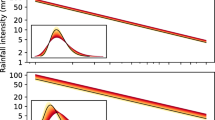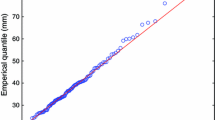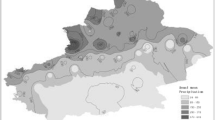Summary
A time series and extreme value analysis of maximum precipitation for distinct time intervals from 10 minutes to 1 day have been deduced for the observatory Zagreb-Grič (ϕ = 45°49′ andλ = 15°59′,H s = 157 m) for the period between 1908 and 1985. The Spearman rank correlation test revealed that the short-term precipitation maxima series for the time intervals of 10 to 30 minutes and 8 to 24 hours indicate no significant trend for the 95 percent probability level. The 40-minute to 4-hour precipitation maxima exhibited an increaese in recent time. Annual maximumt-minute precipitation was estimated using the Gumbel distribution for sets of data gradually prolonged with 10-year steps towards the past. The ratios (q) of maximum precipitation estimates for the shorter periods and of estimates for the reference period (1908–1985) have been calculated. Their positions according to the confidence interval on the reference estimates were determined. Confident extreme value estimates could be obtained using at least the 50–60 year data series.
Similar content being viewed by others
References
Gajić-Čapka, M., 1982: Varijabilnost prosječnog oborinskog režima šire zagrebačke regije (Variability of the Zagreb-Area Mean Precipitation Regime — English Summary).Rasprave-Papers 17, 23–40.
Gajić-Čapka, M., Čapka B., 1986: Comparison of Shorttime-interval Precipitation Maxima in Different Precipitation Climate Zones. Proceedings of the XIV International Conference on Alpine Meteorology, Rauris, Austria, 1.–6. Sept. 1986, 86–90.
Gumbel, E. J., 1958:Statistics of Extremes. New York: Columbia Univ. Press, 375 pp.
Jenkinson, A. F., 1969: Statistics of Extremes. Estimation of Maximum Floods. WMO Tech. Note No. 98, Chapter 5, 183–257.
Jenkinson, A. F., 1977: The Analysis of Meteorological and Other Geophysical Extremes. Met 0 13 Technical Note No 58, unpublished.
Pleško, N., Šinik, N., 1968: Sekularne varijacije oborine u odnosu na Atlas klime SFRJ (Secular Variations of Precipitation for the Purpose of a Climatic Atlas of the SFRJ of Yugoslavia). Hydrometeorological Institute, Zagreb, 32 pp.
Sevruk, B., Geiger, H., 1981 : Selection of Distribution Types for Extremes of Precipitation. Operational Hydrology, Report No. 15, WMO, Geneve, 64 pp.
Simiu, F., Filliben, J., 1975: Statistical Analysis of Extreme Winds. Nat. Bureau of Standards, Tech. Note 868, Washington.
Tabony, R. C., 1983: Extreme Value Analysis in Meteorology.Meteor Mag. 112, 77–98.
WMO, 1966: Climatic Change. Technical Note No 79, 65–66.
Author information
Authors and Affiliations
Additional information
With 3 Figures
Rights and permissions
About this article
Cite this article
Gajić-Čapka, M. Maximum precipitation for different short-term intervals. Theor Appl Climatol 41, 33–39 (1990). https://doi.org/10.1007/BF00866200
Received:
Revised:
Issue Date:
DOI: https://doi.org/10.1007/BF00866200




